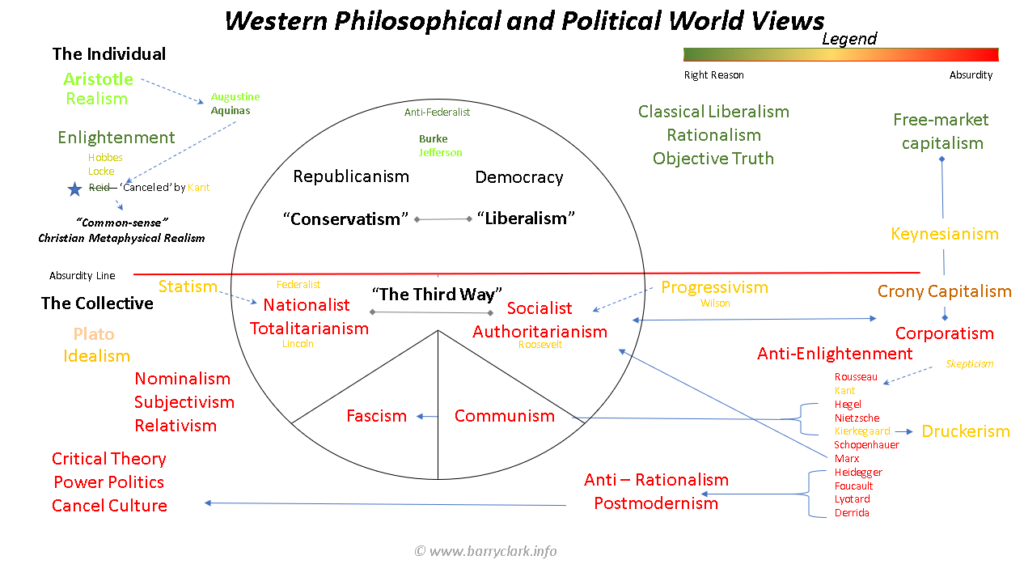
We often view the world through a limited perspective and fail to see the larger narrative, the foundational differences in world views. A liberally inclined person may look at some conservative ideas and see totalitarianism. A conservative invariably does the same, they see authoritarianism at the end of socialism. Neither is absolutely wrong, but it is also unlikely that when a person right or left speaks these words or has these thoughts that they understand why this is true.

Within the umbrella of the philosophy of the Enlightenment, within the context of millennia of Western political, philosophical and theological thought, both left and right, conservative and liberal ideas of freedom, economics and government exist side by side. They are complementary, they share the same basic world view. Conservatism and liberalism, left and right, in the Western tradition, are based upon realism, rationalism, and acceptance of truth - this is Classical Liberalism.
The image above represents the various ideations of thought that derive from the Enlightenment. Obviously there is a vast swath of difference across this spectrum but at the core the most rigid forms of republicanism and the most liberal forms of scientific socialism share in common an acceptance of materialism, rationalism, realism and objective truth. From right to left, there is a difference in agreement as to what constitutes objective truth but everything that is true to the Enlightenment, everything above the 'cut line' agrees on the foundational world view, there is an agreement that truth exists.
Postmodernism
The Enlightenment itself was subjected to a counter-revolution, beginning with Immanuel Kant and continuing through philosophers like Søren Kierkegaard and Friedrich Nietzsche and finally to the modern era and postmodernism. The counter-revolution was a slow but steady assault on the ability of men to know truth and finally of the existence of truth at all.

This shift perverted the classical liberalism philosophical spectrum. Without an understanding of the nature of man, universal truths, natural moral law, and natural rights the poles of the spectrum devolved into dangerous ideologies. Far-right republicanism gives birth to statism, far left progressivism gives birth to pseudo-marxism and totalitarian communism. Finally, a third way was born to address the inadequacies of perverted classical liberal ideologies, fascism, a phenomenon that can exist on the right and left of the spectrum below the classical liberal cut line.
The great political divide we observe at almost all levels of the process is a direct result of the abandonment of truth, or perhaps agreeing that truth exists. No longer does the definition of liberal or conservative reach across the spectrum to some degree as it did under a classical liberal view, no longer is there a middle. To be certain, there are still those that term themselves conservative and liberal but almost all on each side have succumbed to various postmodern ideological influences. This must invariably lead to some sort of totalitarianism, a form of fascism.
Postmodernism is an intellectual stance or a mode of discourse that rejects the possibility of reliable knowledge, denies the existence of a universal, stable reality, and frames aesthetics and beauty as arbitrary and subjective. It can be described as a reaction against scientific attempts to explain reality with objective certainty, recognizing that reality is constructed as the mind tries to understand its own personal circumstances. It is characterized by an attitude of skepticism, irony, or rejection toward the grand narratives and ideologies of modernism, often denying or challenging the validity of scientific inquiry, or declaiming the arbitrariness of the aesthetics of artistic works or other artifacts of cultural production, or questioning various assumptions of Enlightenment rationality.
Postmodernism relies on critical theory, an approach that confronts the ideological, social, and historical structures that shape and constrain cultural production. Common targets of postmodernism and critical theory include universalist notions of objective reality, morality, truth, human nature, reason, language, and social progress. Postmodernist approaches have been adopted in a variety of academic and theoretical disciplines, including political science, organization theory, cultural studies, philosophy of science, economics, linguistics, architecture, feminist theory, and literary criticism, as well as art movements in fields such as literature and music.
Why This Matters
Everything that derives from postmodernism is poison to the Western tradition, right reason, morality, and ethics based upon truth. Critical Theory, as applied to Critical Race Theory, has divided the populace by reigniting racism. Feminist Theory has destroyed the family. It has slipped into traditional organizations such as:
- ♦ Most of mainline Christianity in the form of Social Gospel
- ♦ The Southern Baptist Convention and the acceptance of Critical Race Theory
- ♦ The core ideology behind the formation of the megachurch growth, seeker-sensitive and emergent church movements - Peter Drucker, the Leadership Network The Gospel Coalition and others.
- ♦ Almost all of academia.
- ♦ Neoconservatism, neoliberalism and progressivism - meaning most of the Republican and Democratic parties and most of the organizations and individuals that advocate in the public square for either are affected in some way by postmodern ideology.
My daughter asked me recently, "how can two sides look at the evidence and issues related to Trump's impeachment and see the facts so differently?" The answer is simple: people are incapable of thinking from first principles and agreeing on the existence of universal truths. And so it is, so long as the vast majority are mired in bad ideology the situation will persist and intensify.


2 thoughts on “Philosophical and Political Worldviews”
Comments are closed.